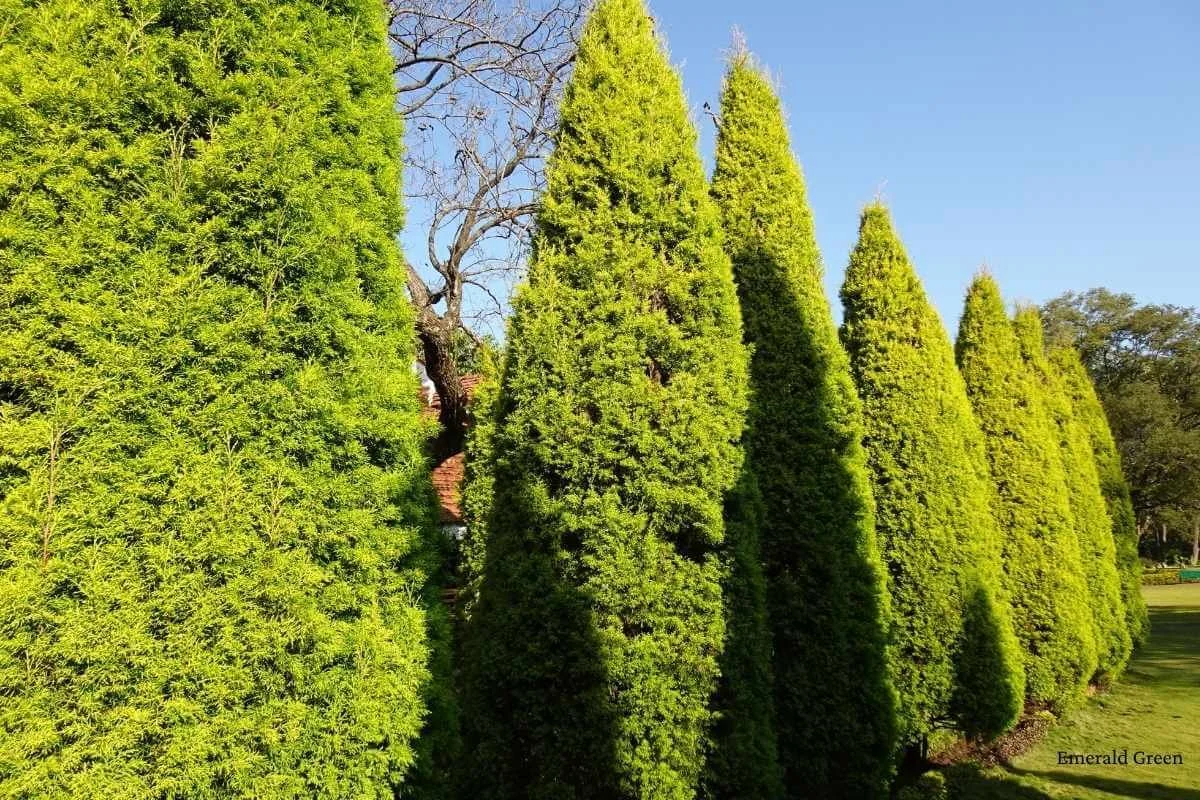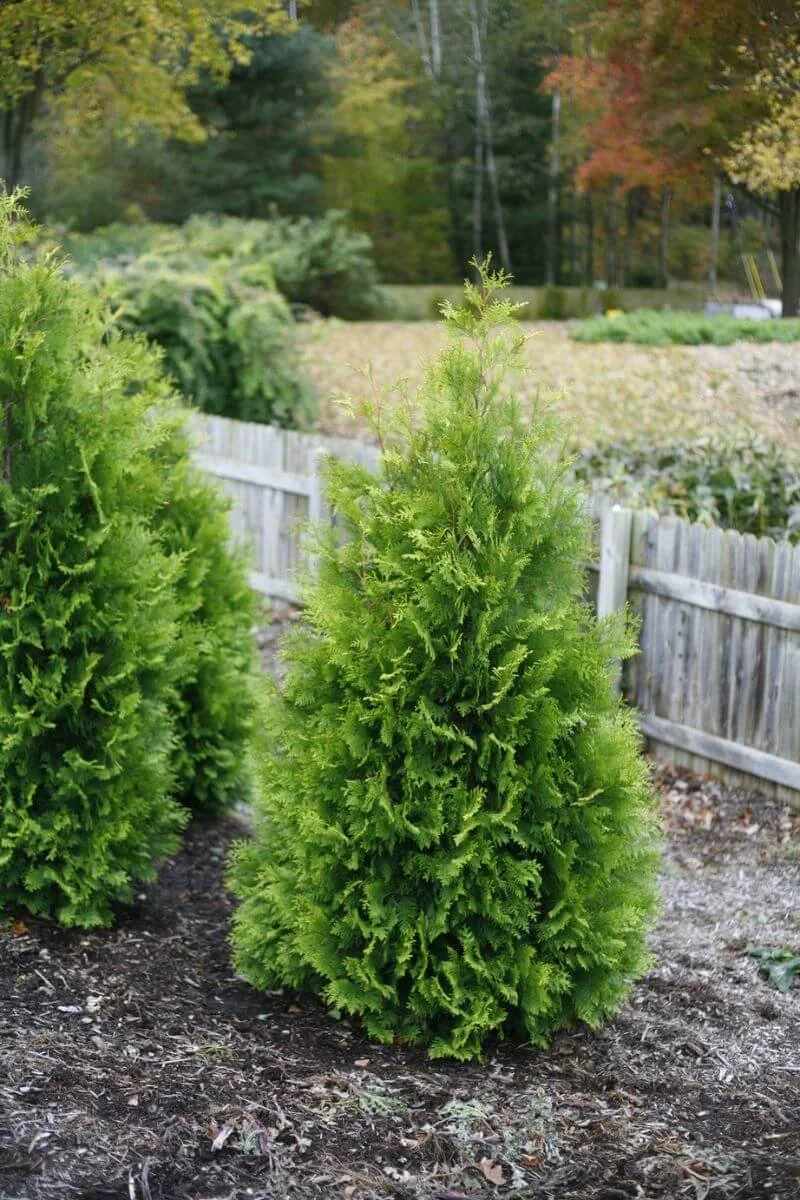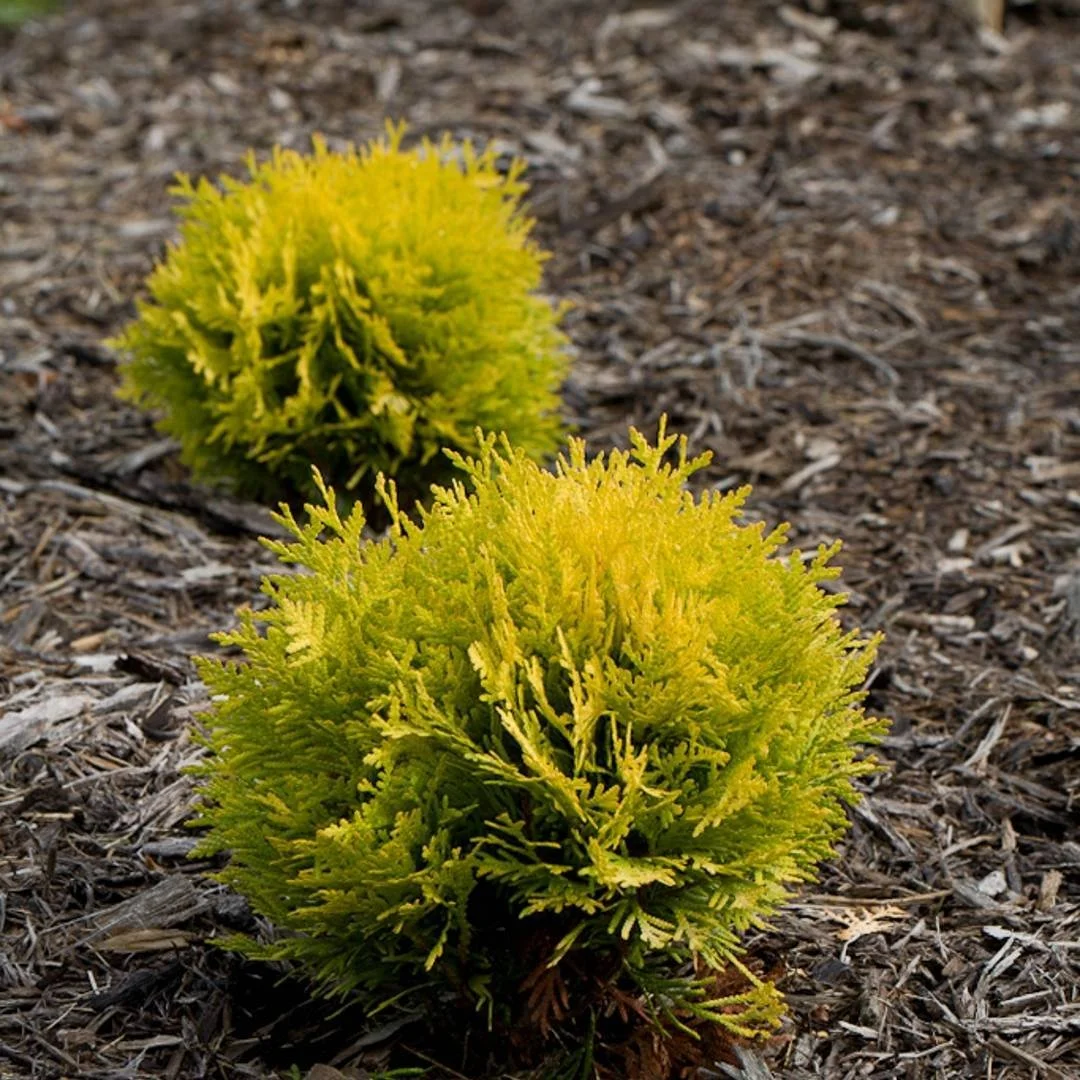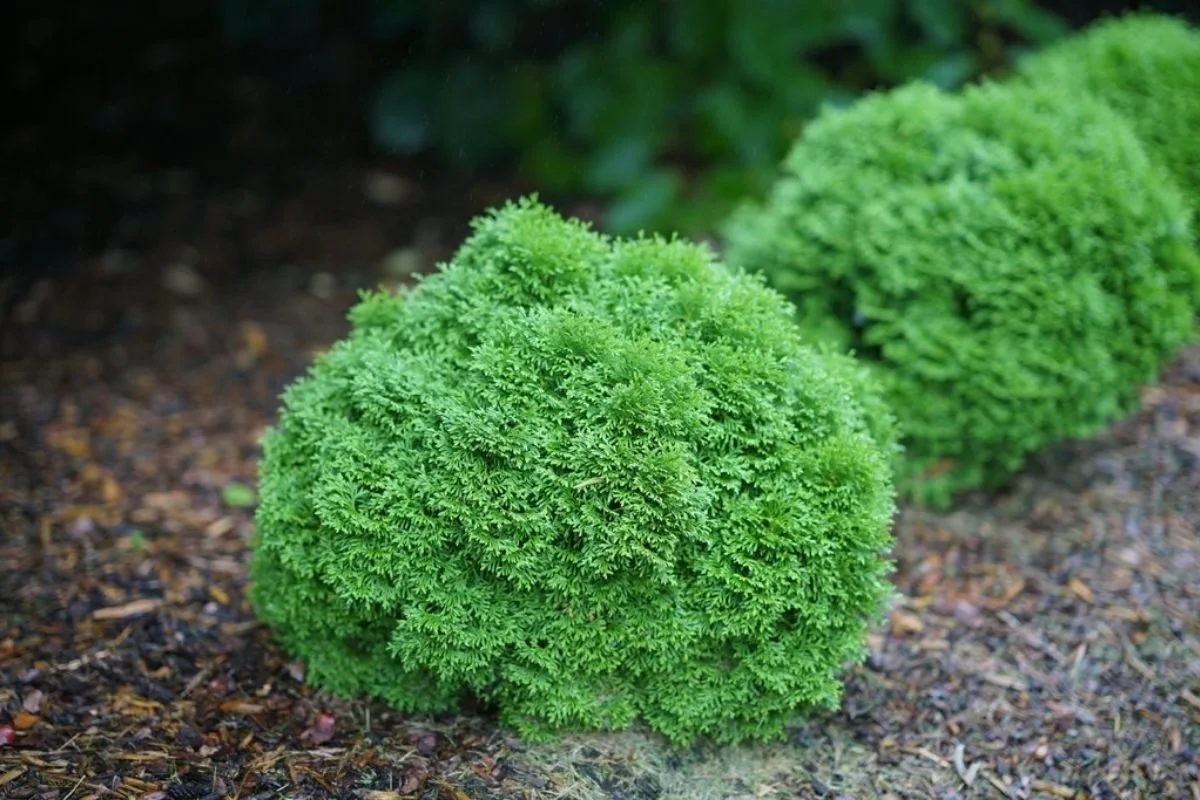10 Exceptional Arborvitae Landscaping Ideas to Try
Discover Beautiful Arborvitae Varieties Beyond Emerald Green and Green Giant
This post contains affiliate links, marked with an asterisk (*). If you click the link, I may receive a small commission at no extra cost to you - please see my policy on affiliate links.
Arborvitae are among the most popular evergreens in American landscaping, and it's easy to see why. These reliable workhorses offer year-round structure, excellent privacy screening, and evergreen interest that never quits. While they have their devoted fans and occasional critics, their popularity speaks volumes about what they bring to the landscape.
You've probably seen the most popular varieties, Green Giant and Emerald Green, lining yards throughout your neighborhood. But did you know there are so many more options available beyond these two staples? These lesser-known varieties offer different widths, shapes, colors, and even better resistance to wind burn!
In this article, we'll take a quick look at the classic Emerald Green and Green Giant, then explore 10 different arborvitae types that might be an even better choice for your landscape.
But first, let's cover a few care basics so your arborvitae landscaping thrives for years to come.
Arborvitae landscaping comes in many shapes and sizes.
Planting & Care Basics for Arborvitae
Arborvitae thrive in full sun where they receive 6 or more hours of direct sunlight daily. They can get by with part shade (3-4 hours), but they won’t be quite as full and lush. Full shade is a definite no, because you will end up with thin, scraggly needles that leave you wishing you'd chosen a different spot.
They transplant easily and grow in a wide range of zones (listed with each variety below), but here's the catch that trips people up: they need consistent moisture. Even after they're established, arborvitae need regular drinks.
If Mother Nature isn't cooperating with soaking rainfall, you'll need to step in and water deeply to reach the entire root ball. Setting up soaker hoses or drip irrigation will make your life so much easier, especially if you're investing in a whole yard's worth of these beauties. Not sure which watering system is right for you? Check out my guide on soaker hose vs. drip irrigation to find the best fit for your landscape.
The other thing to know? Arborvitae are not fans of harsh winter weather. Drying winds, heavy snow, and ice can damage them, so skip the windswept, exposed sites. Keep them well-watered heading into fall so the needles stay hydrated and can better fend off winter damage.
You can protect young plants with burlap wrapping and brush off heavy snow when possible. If you spot brown branches come spring, don't panic! Wait for warmer weather, carefully prune out the damaged bits, then apply a slow-release, balanced fertilizer to encourage fresh, lush growth.
One quick note: don't confuse winter damage (which shows up in spring) with the normal browning of inner needles in fall. That's just natural shedding that all evergreens do as they drop their oldest interior needles.
A Word About Spacing: Throughout this list, I've mentioned "on center" spacing for each plant. This means measuring from the center of one plant to the center of the next, not edge to edge. Want that professionally landscaped look? Grab your tape measure and plot your spacing precisely. It makes all the difference!
“On center” spacing is the distance from the center of one plant to the center of the next plant.
The Classics: Green Giant and Emerald Green
Green Giant Arborvitae
Thuja plicata x standishii 'Green Giant'
Zones: 5-8
Size: 30-50 feet high x 12-15 feet wide
Spacing: 5-10 feet on center
Shop this variety* → at Fast Growing Trees
What does it say about human nature that this is probably the #1 requested plant I encounter? Maybe that we don't particularly like our neighbors and want to screen them out as quickly as possible! 😜
The questions I hear most often: "Can I grow Green Giants? Do I have enough room? Do they really grow that fast?"
Yes, these are extremely fast-growing trees. In optimal conditions, they shoot up 3-5 feet per year and will eventually reach 30-50 feet tall and 12-15 feet wide.
The caveat? They really do grow that tall, so you need to plan for their enormous mature size.
They work wonderfully on large suburban lots, especially around newly constructed homes that need privacy and greenery fast.They're also excellent for creating a sound buffer if you have traffic noise and adequate space.
On the flip side, I've seen entire small to medium backyards in urban areas planted with a perimeter of these giants, and the effect is claustrophobic. They create a towering wall that makes you feel boxed in.
If you have the space and need quick screening, these are fantastic. If not, there are better choices on this list, starting with Full Speed a Hedge at #1.
Landscaping Uses:
Fast-growing screening for large properties
Privacy hedge along property lines
Sound barrier for traffic noise
This Green Giant arborvitae shows exactly why planning for mature size matters - it's completely dwarfing the small tree beside it.
Emerald Green Arborvitae
Thuja occidentalis 'Emerald Green'
Zones: 3-8
Size: 10-15 feet high x 3-4 feet wide
Spacing: 3-4 feet on center for a dense hedge, 5 feet on center for an individual look
Shop this variety* → at Fast Growing Trees
Emerald Green has long been considered a better alternative to Green Giant for those without tons of space, thanks to its compact, columnar shape.
It’s ideal for hiding utility boxes, AC units, or blocking unsightly views like a neighbor's shed. This slow-growing variety is a landscaping staple and workhorse in the nursery industry, yet it gets a surprising amount of hate.
Why? Because they're frequently planted in large numbers as a privacy screen in open, exposed landscapes where they struggle. Make sure they have some protection from harsh elements, and remember they need supplemental moisture.
These plants are still workhorses that will be around for years, but if you're considering Emerald Green, also check out Private Jet at #2 on our list. It grows faster and might work better for your needs.
Landscaping Uses:
Creates a narrow, elegant privacy screen without taking up much yard space
Perfect for lining property boundaries, driveways, or walkways for a polished look
Adds strong vertical accents in garden beds, mixed borders, or foundation plantings
The ubiquitous Emerald Green arborvitae, a landscaping staple you've probably seen in countless yards. Image credit @sarangib via Canva.com
Discover Beautiful Arborvitae Varieties Beyond Emerald Green and Green Giant
1. Full Speed a Hedge (American Pillar)
Thuja occidentalis 'American Pillar'
Zones: 3-8
Size: 25-30 feet high x 4 feet wide
Spacing: 2.5 feet on center for dense privacy, 3-4 feet on center for a looser hedge
Shop this variety* → at Fast Growing Trees
Full Speed a Hedge arborvitae landscaping offers the same screening as Green Giant with a slimmer profile, making it perfect for smaller yards and urban spaces.
Full Speed a Hedge is a great alternative to Green Giant for urban spaces and small yards. This dense, versatile screening plant is narrower and slightly shorter than Green Giant, helping you to avoid that claustrophobic feeling.
It forms a thick evergreen screen and grows amazingly fast (up to 3 feet per year in ideal conditions) while offering excellent wind and cold resistance.
Just like Green Giant, consider the mature height before planting, but you'll appreciate the narrower profile. Bonus: it thrives in colder zones than Green Giant.
Landscaping Uses:
Creates a tall privacy screen with minimal width
Ideal for formal hedges, fence lines, property lines, or driveway borders
Works well in small yards where a compact, upright screen is needed
Offers year-round evergreen structure for modern or classic landscape designs
2. Private Jet
Thuja occidentalis 'King of Brabant’
Zones: 3-7
Size: 15-20 feet high x 4-5 feet wide
Spacing: 3-5 feet on center
Shop this variety* → at Nature Hills Nursery
Private Jet arborvitae is quickly becoming the preferred alternative to Emerald Green, thanks to its faster growth rate. Image courtesy of Van Belle Nursery/Bloomin’ Easy.
Why is it called Private Jet? Because it takes off quickly, growing up to 24 inches per year until it reaches 15-20 feet tall. This variety is rapidly becoming a replacement for Emerald Green because it grows faster and gets the job done in half the time. Perfect for smaller yards and urban spaces, it grows tall but maintains a narrow footprint of just 4-5 feet wide. Create a dense privacy hedge faster? We're in!
Landscaping Uses:
Creates a sleek, narrow privacy screen with a small footprint
Ideal for framing entryways, driveways, or garden focal points with vertical structure
Works well along property lines or fence lines for a tidy, uniform look
Hides ugly views
Screens utility boxes and air conditioning units
Provides dependable year-round texture and height for small or narrow garden spaces
3. Sting
Thuja occidentalis 'SMNTOO'
Zones: 3-8
Size: 15-20 feet high and 1-1.5 feet wide
Spacing: 1-1.5 feet on center
Shop this variety* → at Nature Hills Nursery
Sting arborvitae brings vertical interest to the landscape. Image courtesy of Spring Meadow Nursery, Inc.
An interesting, architectural shape that makes a fun vertical accent for anyone who likes a more formal, structured style. This one is tall and skinny, perfect when you need height in tight quarters.
Landscaping Uses:
Adds dramatic vertical accent in foundation plantings or mixed borders
Perfect for tight spaces where height is needed but width is limited
Creates a narrow privacy screen or green "pillar" effect along property lines
Ideal for flanking entryways, gates, or focal points for a formal look
Great for breaking up long fence lines or walls with year-round evergreen structure
4. Cheer Drops
Thuja occidentalis 'SMNTDGT'
Zones: 3-7
Size: 10-18 feet high and 6-8 feet wide
Spacing: 6-8 feet on center
Shop this variety* → at Nature Hills Nursery
Cheer Drops arborvitae has soft foliage and a tidy, tear-drop shaped form. Image courtesy of Spring Meadow Nursery, Inc.
I have to admit, I love this plant! It has a soft, interesting look and does a better job in many instances at lining a boundary and creating a privacy screen than Emerald Green, though it's not quite as narrow. No shaping needed, this beauty keeps its handsome teardrop shape and looks architecturally interesting on its own. It brings more varied texture to your backyard arborvitae landscaping. Plus, it grows in Zone 3, which many arborvitae don't tolerate.
Landscaping Uses:
Creates effective screening in backyards and side yards with unique teardrop form
Provides privacy along property lines with architectural interest
Adds vertical accent to mixed borders with soft texture
Works beautifully in conifer gardens as a specimen plant
Screens air conditioning units and chain linked fencing
Cheer Drops makes a nice backyard or side yard privacy screen. Image courtesy of Spring Meadow Nursery, Inc.
5. Polar Gold
Thuja occidentalis 'SMTOYB'
Zones: 3-7
Size: 12-15 feet high and 4-6 feet wide
Spacing: 4-6 feet on center
Polar Gold arborvitae delivers vibrant, year-round golden color to brighten any landscape. Image courtesy of Spring Meadow Nursery, Inc.
Polar Gold arborvitae is a pretty golden variety that offers something different from the standard green. It maintains a relatively narrow footprint while bringing soft texture and a formal shape to your landscaping with arborvitae. It holds a dense, narrow pyramid shape naturally, so no pruning needed, and it grows faster than some other gold varieties on the market.
Landscaping Uses:
Adds bright, year-round golden color to garden beds and borders
Perfect as a privacy screening or dense hedge
Mass planting along property lines or fences
Stand alone specimen plant
Part of a mixed conifer garden
6. North Pole
Thuja occidentalis 'Art Boe'
Zones: 3-7
Size: 10-15 feet tall x 3-5 feet wide
Spacing: 3-5 feet on center
Shop this variety* → at Fast Growing Trees
North Pole arborvitae is a great choice for urban gardens and narrow spaces. Image courtesy of Proven Winners, provenwinners.com
This narrow, upright pyramidal shape is even more slender than Emerald Green at just 3-5 feet wide. It resists winter burn beautifully and is a better choice for small yards, urban gardens, and narrow spaces where you need height without bulk.
Landscaping Uses:
Creates a sleek vertical accent in foundation beds or mixed borders
Perfect for narrow privacy screens along property lines or fences
Ideal for framing entryways, gates, or garden focal points with a clean, upright form
Works well in small yards or tight spaces where height is needed without width
North Pole arborvitae and colorful annuals define this backyard patio space. Image courtesy of Proven Winners, provenwinners.com
7. Whip It Good
Thuja occidentalis 'RutThu2'
Zones: 3-7
Size: 3-5 feet high x 3-5 feet wide
Spacing: 3-5 feet on center
Whip It Good arborvitae brings a quirky shape and interesting texture to garden beds and borders. Image courtesy of Spring Meadow Nursery, Inc.
This is a brand-new arborvitae that will land in garden centers in 2026, and it's so cool looking! It brings interesting texture to your landscape with long, thin leaves and a whimsical, grass-like appearance. It grows faster and has a nicer shape than the older "Whipcord" variety. A low-maintenance, versatile choice for modern designs.
Landscaping Uses:
Adds unique texture and a flowing, fountain-like form to garden beds and mixed borders
Ideal for softening hard edges around rocks, pathways, or retaining walls
Works beautifully in modern or Asian-inspired landscapes for a sculptural look
Great as a low foundation plant where a distinctive, evergreen mound is needed
Excellent in containers for year-round interest and eye-catching texture
8. Fire Chief
Thuja occidentalis 'Congabe'
Zones: 5-8
Size: 2-4 feet high and wide
Spacing: 3-4 feet on center
Shop this variety* → at Nature Hills Nursery
Golden leaves tipped with orange give Fire Chief arborvitae its signature glow. Image courtesy of Southern Living Plant Collection.
I love this one for its unique foliage color. Golden leaves are kissed with shades of orange that become more red as autumn approaches. It stays compact and has a strong tolerance to wind burn. I love planting it behind catmint or Russian sage because the colors together are absolutely striking if you want a bold color scheme with your arborvitae shrubs for landscaping.
Landscaping Uses:
Adds vibrant year-round color with red-orange foliage, perfect for brightening borders
Ideal tidy foundation shrub that stays compact without pruning
Works beautifully in mixed plantings to create contrast with dark green or blue evergreens
Excellent in containers or small-space gardens where compact form is needed
9. Anna’s Magic Ball
Thuja occidentalis 'Anna van Vloten'
Zones: 3-8
Size: 2-3 feet high x 3-4 feet wide
Spacing: 3-4 feet on center
Shop this variety* → at Fast Growing Trees
Anna’s Magic Ball arborvitae glows with bright golden-green foliage and a tidy, year-round globe shape. Image courtesy of Proven Winners, provenwinners.com
This dense, rounded beauty features bright golden-green foliage that literally glows in the garden. The easy-to-grow, globe-shaped form brings year-round structure and is perfect for small spaces and tidy borders. I love seeing a row of Anna's Magic Ball planted in front of hydrangeas to create an elegant, structured edge. It also pairs beautifully along side Double Play Doozie spirea because the golden-green foliage makes a lovely contrast with the spirea's bright purple-red flowers.
Landscaping Uses:
Perfect for adding bright, year-round color to small garden beds and borders
Ideal as a low, tidy foundation plant that won't outgrow its space
Great for lining pathways or edging mixed plantings with neat structure
Works well in townhome gardens and small spaces where compact form is essential
Excellent in containers for pops of evergreen texture on patios or flanking entryways
10. Tater Tot
Thuja occidentalis 'SMNTOBAB'
Zones: 3-8
Size: 2-3 feet high x 3-4 feet wide
Spacing: 3-4 feet on center
Shop this variety* → at Fast Growing Trees
This petite, naturally round arborvitae adds tidy year-round structure, even in shadier spots. Image courtesy of Proven Winners, provenwinners.com
Cute and very useful, this small globe-shaped arborvitae naturally maintains its round form with no pruning needed. It's more shade-tolerant than most arborvitae, making it perfect for bringing structure to the shadier areas of your yard. The green foliage stays dense and tidy year-round.
Landscaping Uses:
Ideal as a small, tidy foundation plant that stays naturally well-shaped
Great for edging pathways or defining borders with consistent structure
Perfect for small gardens or tight spaces where a compact evergreen is needed
Works well in mixed beds to add year-round texture without overwhelming surrounding plants
Excellent in containers for a neat, low-maintenance evergreen accent
Make Your Arborvitae Landscaping Dreams a Reality
There you have it! Ten exceptional alternatives to the standard Emerald Green and Green Giant that can bring new shapes, sizes, colors, and textures to your landscape design. Whether you're working with a sprawling suburban lot or a cozy urban garden, there's an arborvitae variety perfectly suited to your space.
Remember, success with arborvitae comes down to choosing the right variety for your conditions and committing to consistent watering, especially during their first few years and heading into winter. With proper care and smart placement, these evergreen beauties will reward you with year-round structure and privacy that looks professionally designed.
Helpful Resources:
USDA Zone Finder (find your hardiness zone)
US Drought Watch (check current drought conditions)
How to Water Your Plants (my complete watering guide)
Defining Full Sun to Part Shade (understand your light conditions)
10 Tall and Narrow Plants (more screening ideas for your landscape)
Happy planting! 🌿
*Where to Buy These Arborvitae Varieties*
Ready to add these exceptional arborvitae to your landscape? I've partnered with trusted online nurseries that offer quality plants and reliable shipping. Click the variety name to shop:
Nature Hills Nursery* makes it easy to shop premium plants online with expert-grown quality you can count on.
Green Giant* | Emerald Green* | Full Speed a Hedge* | Private Jet* | Sting* | Cheer Drops* | North Pole* | Fire Chief* | Anna's Magic Ball* | Tater Tot*
Fast Growing Trees* delivers healthy, landscape-ready trees and shrubs right to your home.
Green Giant* | Emerald Green* | Full Speed a Hedge* | Private Jet* | Sting* | North Pole* | Fire Chief* | Anna's Magic Ball* | Tater Tot*
Note: Availability varies by season
Disclosure: As an affiliate, I may earn a small commission from purchases made through these links at no additional cost to you. I only recommend nurseries I trust and believe offer quality plants and service.
Pin to Save this Article:
Follow Plant and Bloom Design Studio for More Landscape Design Ideas
Frequently Asked Questions About Arborvitae Landscaping
The best arborvitae for landscaping depends on your space and needs. For small yards, Private Jet or North Pole offer narrow profiles with excellent privacy screening. For larger properties, Full Speed a Hedge provides fast growth without the overwhelming size of Green Giant. If you want color, Fire Chief and Polar Gold bring golden-orange and bright yellow tones. Consider your mature size requirements, hardiness zone, and whether you need a hedge or standalone feature plant.
How far apart should I plant arborvitae for a privacy screen?
Spacing depends on the variety you're planting. I've listed the recommended spacing for each arborvitae type highlighted in this article right alongside the plant information. If you're planting a variety not mentioned here, check the plant tag for spacing guidelines or ask nursery staff for recommendations based on the mature width. Always measure "on center," from the center of one plant to the center of the next, not edge to edge. Avoid spacing too close, as overcrowding leads to poor air circulation and increased disease risk.
Do arborvitae need a lot of water?
Yes, arborvitae need consistent moisture throughout their life, not just during establishment. This is the most common reason for arborvitae failure. Water deeply to reach the entire root ball, especially during dry spells and heading into winter. Arborvitae are not drought-tolerant "set it and forget it" plants. Installing soaker hoses or drip irrigation makes consistent watering much easier, particularly when landscaping with arborvitae as a hedge.
What is the fastest growing arborvitae for privacy?
Full Speed a Hedge (American Pillar) and Green Giant are the fastest-growing arborvitae, both reaching up to 3-5 feet per year in ideal conditions. Private Jet grows up to 24 inches per year, making it faster than Emerald Green while maintaining a narrow profile. For backyard arborvitae landscaping in smaller spaces, Private Jet or Full Speed a Hedge offer the best combination of speed and manageable size.
Can arborvitae grow in shade?
Arborvitae prefer full sun to part shade. Too much shade causes the foliage to thin out and become sparse. However, some varieties like Tater Tot tolerate more shade than others, making them useful for shadier areas of your yard. For the densest, healthiest growth, aim for at least 4-6 hours of direct sun daily. Avoid planting arborvitae in deep shade or areas that receive only a little morning or late afternoon sun.
How do I protect arborvitae from winter damage?
Protect arborvitae from winter damage by keeping them well-watered through fall so needles stay hydrated against drying winds. Avoid planting in windswept, exposed locations. Wrap young plants with burlap for their first few winters and brush off heavy snow to prevent branch breakage. Varieties like North Pole and Full Speed a Hedge offer better natural resistance to winter burn. If you see brown branches in spring, wait until warm weather returns, prune them carefully, and apply balanced fertilizer.
What arborvitae is better than Emerald Green?
Private Jet is rapidly replacing Emerald Green because it grows twice as fast (up to 24 inches per year vs. 12 inches) while maintaining a similarly narrow profile. North Pole is another excellent alternative with a slimmer width (3-5 feet) and better winter burn resistance. Also consider Cheer Drops, which offers a softer teardrop shape and cold hardiness to Zone 3. The "better" choice depends on your growth speed needs, available space, and climate zone.

















